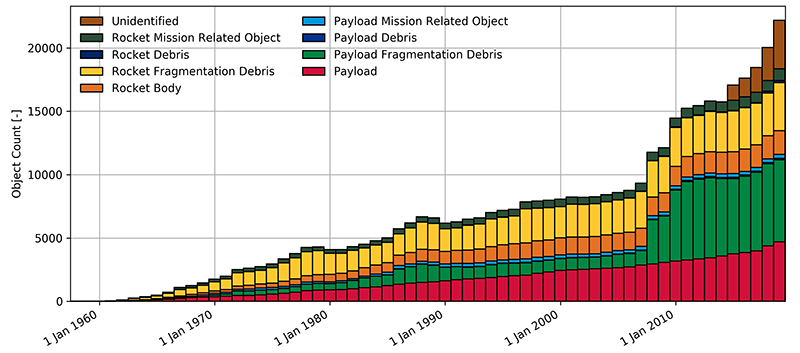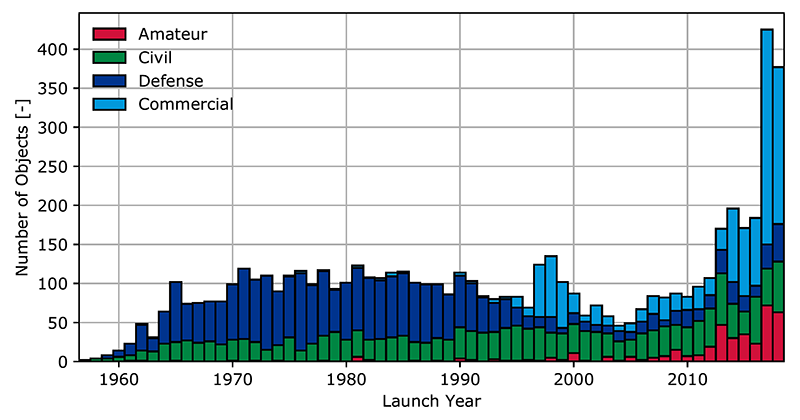In 2016, the European Space Agency’s (ESA) Copernicus Sentinel-1A satellite experienced a sudden dip in power and a physical jolt while orbiting 700 kilometers above Earth. The culprit turned out to be a millimeter-sized speck of space debris that hit one of the solar panels. It left a 40-centimeter dent.
Right now, “there are already 20,000 objects that are tracked from the ground out there, and there are close to 1 million objects larger than 1 centimeter, the majority of which are too small to be tracked,” Holger Krag, head of ESA’s Space Debris Office, told Eos. “All of them pose a significant risk to space objects.”
“At the moment, we see…a pretty much unchallenged degradation of the environment as compared to what we’ve seen in the past.”
Space debris is defined as anything artificial that clogs up space near Earth, including defunct satellites, used rocket stages, and payload components expunged after use. Each year, ESA documents the current state of the space debris environment and how it has changed since Sputnik launched in 1957. This year’s report, which was released in May, makes two things clear: Near-Earth space is increasingly polluted, and humanity must work harder to clean it up.
“It is definitely a bit of a pessimistic outlook that we have,” Krag said. “At the moment, we see…a pretty much unchallenged degradation of the environment as compared to what we’ve seen in the past.”
“In the past 10 years, the problem of debris has become very real,” Stijn Lemmens, a space debris mitigation analyst at ESA and lead author of the report, told Eos. “At least once a week, [ESA] will have to maneuver one of our spacecraft, interrupt our normal science operations to move out of the way, and move back because there is a piece of debris coming by.”
The Scope of the Problem
As of January 2019, there were around 34,000 objects larger than 10 centimeters orbiting Earth (Figure 1). Only about 2,000 of those are active satellites. Statistical models suggest that there are about 900,000 debris objects larger than 1 centimeter and about 130 million larger than 1 millimeter.

“The majority of space debris objects in orbit are due to breakups, due to literal explosions of what used to be intact objects like upper stages [of rockets] or satellites, or due to the residual energy sources on board—fuel, pressure in tanks, charged batteries, and so on,” Krag explained. “Over time, they tend to fall apart, or some of them literally explode.”
Other debris comes from collisions. “Two objects colliding in space at an average velocity of 36,000 kilometers per hour can have more severe effects than an explosion of an object,” Krag said. “Several fragments would be left behind by such a collision.” Antisatellite operations also add to the fragment count, he added.
Every new fragment can lead to more fragments later on, exacerbating the problem. “These breakups need to stop,” Krag said.
Protected Regions
The video below from ESA shows the positions of tracked and simulated debris objects. Red dots represent active or defunct satellites, yellow dots represent rocket bodies, green dots represent miscellaneous mission-related objects, and blue dots represent fragments:

Two regions immediately stand out as especially congested: the space immediately above Earth’s surface, called low-Earth orbit (LEO), and a band farther out that’s aligned with the equator, called geostationary orbit (GEO). LEO and GEO encompass sets of orbits that are particularly useful for communications and observing Earth and space.
The Inter-Agency Space Debris Coordination Committee, an international governmental forum for coordinating space debris activities, defined LEO and GEO as protected regions. It proposed a set of guidelines to mitigate the creation of space debris there. Those guidelines, however, only work when spacecraft comply with them.
“Unfortunately, we still have quite a bit to do in terms of the way we use our spacecraft in low-Earth orbit.”
“In terms of GEO, the number of missions which do not respect the guidelines—essentially, when your mission is over, clear the GEO region by reorbiting yourself to a higher altitude—we see that we are asymptotically converging on a compliance rate of around 90% in this region,” Lemmens said. “This is pretty good, especially coming from below 40% 2 decades ago.”
In low-Earth orbit, “the guideline says that any object, when its mission is over, [should] have a remaining orbital lifetime lower than 25 years or be maneuvered out of LEO,” he said. Only about 5%–15% of satellites that don’t follow the first recommendation actually comply with the second, “which is very low.”
“Overall, unfortunately, we still have quite a bit to do in terms of the way we use our spacecraft in low-Earth orbit,” Lemmens added. “But it’s clear from the examples of rocket bodies and satellites in GEO that if we want to change something, we can.”
Who Goes to Space?
“We have a completely new era of spaceflight,” Krag said. “Spaceflight of the past was basically state owned, public, so it was the taxpayers’ money funding the missions. And now we see academics, amateurs, and, in particular, commercial companies starting to explore space.”
The pace of launches has sharply spiked in recent years and will continue to grow (Figure 2). “The number of launches we are expecting in the next 3 years will outnumber the number of launches the whole of humanity has done in the history of spaceflight,” Krag said.

Lemmens explained that making space more accessible is, overall, a good thing, especially when it brings new people into the spaceflight community. But it is also contributing to the space junk problem.
“At the moment, it’s a bit of a Wild West out there,” he said. “As long as you can pay for yourself to get into orbit, regulations about what you can and cannot do are quite light. [Regulations] are changing, but they need to put the notion of responsible behavior onto the person who is launching and on the person who is developing.”
Making Space Junk Free
Stopping the spread of space debris and being respectful of orbital space will require a collective change in mentality, according to Lemmens.
“We really should start thinking…, ‘Where can I go with my satellite?’ ‘What mission makes sense?’ and ‘How am I affecting the operators around me that are already there?’” he said. Satellites that can’t maneuver to avoid a collision, as with most CubeSats and ChipSats, should avoid already crowded orbits, Lemmens added.
“Before any talk of remediation, it’s about making sure we mitigate and stop polluting.”
ESA and others have proposed so-called active removal missions to sweep up or deorbit space debris, Krag said, but these missions are costly and won’t be able to get it all. More promising, he said, are onboard technologies to automatically shut down or control satellite systems if fragmentation seems imminent.
“It’s definitely cheaper to equip your spacecraft right from the start with the means to make sure that it can dispose of itself rather than asking and paying for someone to remove it,” he said.
But first and foremost, Lemmens said, “is to implement the recommendations that are already out there. Before any talk of remediation, it’s about making sure we mitigate and stop polluting.”
—Kimberly M. S. Cartier (@AstroKimCartier), Staff Writer
Citation:
Cartier, K. M. S. (2019), Space is polluted by junk…and it’s getting worse, Eos, 100, https://doi.org/10.1029/2019EO126009. Published on 12 June 2019.
Text © 2019. AGU. CC BY-NC-ND 3.0
Except where otherwise noted, images are subject to copyright. Any reuse without express permission from the copyright owner is prohibited.
Text © 2019. AGU. CC BY-NC-ND 3.0
Except where otherwise noted, images are subject to copyright. Any reuse without express permission from the copyright owner is prohibited.

